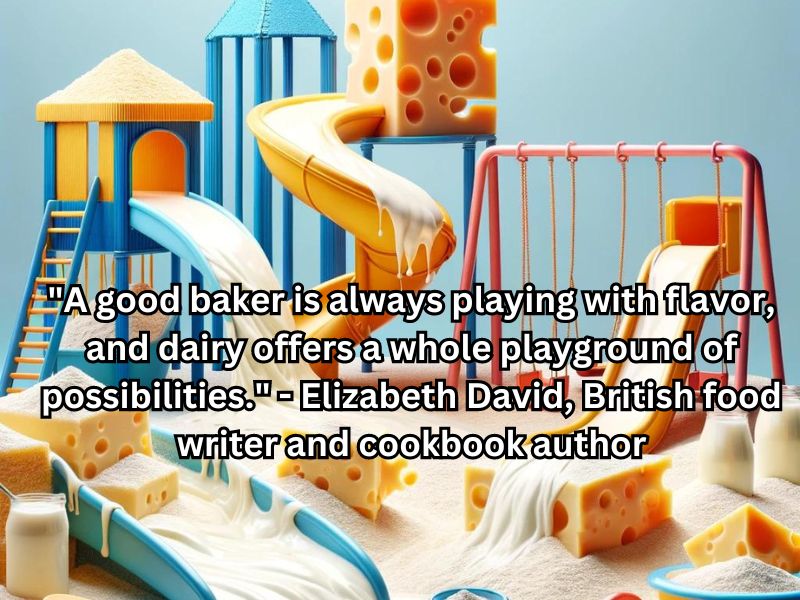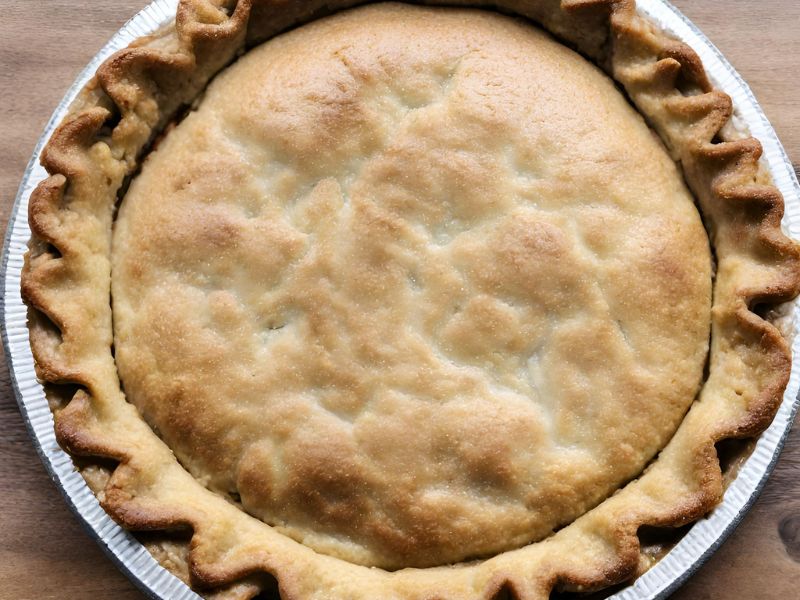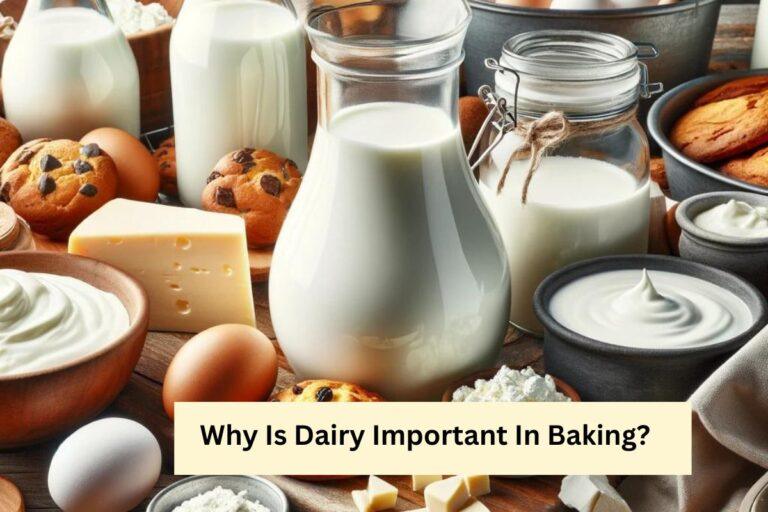Dairy provides the ideal moisture, fat, sugars, and proteins for tender, well-risen baked goods with balanced, appetizing flavors and beautiful browning
Provides Moisture and Richness

When you think about dairy, you probably think about its ability to make baked goods nice and moist. Ingredients like butter, milk, and cream cheese add both fluid moisture and healthy fats that keep your treats from drying out.
Let’s start with everyone’s baking BFF – butter. The fat content in butter creates those sublime, flaky layers in your pie crusts and pastries. Bit of melted butter in your cookie dough? That’s why they stay so soft and chewy on the inside.
Using full-fat dairy products like whole milk and heavy cream adds similar moisture and richness. Things like cream cheese and sour cream contain less liquid but still make baked goods rich and soft.
Pay attention to labels – using low-fat or non-fat dairy may save calories, but you lose out on that mouthfeel. For tender crumbs and rich flavor, go for full-fat dairy products when baking.
Helps Baked Goods Rise
You want your cakes, breads, and muffins to reach for the skies, right? Something about a perfectly rounded cake or golden loaf just feels special. The dairy you add plays a key role in lift and rise.
When mixed into doughs and batters, fats like melted butter and oil coat strands of flour to prevent over-gluten development. This allows room for the expansion of air bubbles and pockets as your goods bake. As the bubbles and pockets expand, they lift the dough or batter, causing it to rise. So these air pockets created from the fats are literally what helps your baked goods increase in volume and “rise up” as they bake.
The steam created from liquid ingredients like milk, buttermilk, and yogurt also expands in the heat of the oven, further lifting your breads and cakes. Pay attention to what type of dairy you use, as lower-fat products won’t prevent tough textures. For dairy that helps baked goods reach their full rising potential, stick to fuller fat options like whole milk, sour cream, or creamy yogurt.
Brings Flavor to the Party

We all know the heavenly taste of melted butter, the sweet tang of yogurt, and the velvety richness of cream. Dairy products bring some scrumptious flavors to baked goods that take them to the next level.
The creamy, fatty flavor of butter is classic, adding both seasoning and luxury. Tangy dairy like sour cream, buttermilk, and lemon yogurt offer bright notes to balance out sweetness. They make cakes, quick breads, and muffins shine. Even small amounts of flavored cream cheese frostings or a topping of sweetened whipped cream can work magic.
Pay attention to labels when picking dairy for the best flavor. Low-fat milk or coconut yogurt won’t carry the same full, complex taste. And don’t overlook aged cheese in savory baking either – a little parm or cheddar in biscuits adds a tasty punch. For yummy goodness in every bite, let the natural flavors of quality dairy shine through.
Helps Things Brown

Have you ever taken chocolate chip cookies out of the oven that were perfectly browned? Or admired the glossy, amber-colored topping of a pecan pie? You have dairy to thank for that picture-perfect browning.
It turns out caramelized oven products not only look gorgeous but taste pretty good, too. When exposed to heat, the natural lactose and proteins found in most dairy undergo the Maillard reaction. This chemical process allows baked goods to brown, taking on thousands of complex, toasty flavors.
Ingredients like cheese contain amino acids that boost the reaction further. So, for cookies that turn a perfect golden brown or pie with a glossy maple-colored shine, be sure to include a decent dose of dairy in your recipe. A splash of milk, a few pats of butter, and a sprinkling of cheese can work visual (and flavor) magic.
How Dairy Stars in Recipes
🥧 Key Dairy Ingredients Across Your Favorite Baked Goods 🧇
| 🍪 Common Baked Goods 🥧 | 🥛 Key Dairy Roles 🧈 |
| Cookies 🍪 |
|
| Cakes 🎂 |
|
| Pie Crusts 🥧 |
|
Brought To You by: wearebaking.com 🧁
Cookies rely on butter for chewy centers and lacy edges. The fat tenderizes while the milk proteins and sugar promote browning.
Pie crust becomes flaky and structured with solid butter layers. In cakes and cupcakes, milk adds moisture, fat bolsters texture, and tangy yogurt or buttermilk balances out the sweetness.
As for creamy fillings and frostings, dairy is the true MVP. From buttercream to cheesecake filling, you need the rich mouthfeel and smooth consistency that dairy provides.
Savory biscuits and bread turn even more tempting with a brush of milk wash on top or the addition of shredded cheddar. Keep in mind that dairy is key to creating all your favorite baked treats!
Tips For Success
Here are some tips when baking with dairy:
When baking, read your recipe closely to see if it calls for whole milk, skim milk, heavy cream, etc. Using the exact dairy ingredient matters. For example, cakes made with whole milk versus skim milk will turn out with different moisture and richness levels. This is because dairy ingredients like milk, yogurt, and cream contain different amounts of proteins, fat, and moisture.
Temperature is key, too -For example, cold butter needs to be cut into dry ingredients for biscuits or pie crusts; soft or melted butter will just separate when mixing it in, and you can say goodbye to those flaky layers.
Let cream cheese fully soften to room temperature. Softened cream cheese mixes more smoothly into frosting, and you can avoid those pesky lumps.
Finally, dairy can spoil quickly, so taste-test before adding to a whole cake.
Follow these tips for delicious successful baked goods.
Frequently Asked Questions
Here are answers to some frequent questions bakers have about dairy’s role in recipes.
What does dairy do in baking recipes?
In simple terms, dairy adds moisture, richness, tenderness, and flavor. Butter and milk impact the texture of items like cookies and pie dough by limiting gluten development and contributing hydration. The fats and proteins also aid browning through the Maillard reaction, and steam assists leavening. Components like cream cheese and yogurt provide fatty richness and tangy taste. Think of dairy as the “glue” tying together structure, softness, and flavor.
Is milk necessary for baking?
While you can sometimes substitute water or non-dairy alternatives, milk is uniquely formulated to provide the ideal moisture, sugar (lactose), fat, and proteins to facilitate baking chemistry. The steam milk creates lends a hand to rise and lift. The sugars assist with appealing Maillard browning while the fat tenderizes textures. You especially want dairy for items like custards where the proteins coagulate.
What is the purpose of milk and cream in baking?
In most recipes, the liquids provide moisture and fat for tenderness as well as sugars that promote appetizing browning. Specifically, milk assists with lift from steam and healthier gluten development. Heavy cream provides even more fat for super soft, rich outcomes. Items made with cream also whip up lighter than milk-based versions. Together they hydrate, tenderize, and flavor your baked creations.
What is the science behind milk in baking?
On a molecular level, the water, sugars, proteins, and fats in milk all play a role. Water hydrates flour, allowing the proteins to absorb liquid to produce gluten and rise. Lactose sugars undergo caramelization for appealing aromas/flavors. Dairy proteins themselves denature and brown. Finally, milkfat tenderizes texture, produces steam, and conducts heat – impacting the very cell structure that forms as batter bakes.
Key Learning Points
- Dairy provides moisture and richness – Ingredients like butter, milk, cream cheese add tenderness, keep baked goods from drying out, and contribute indulgent textures and mouthfeel.
- Dairy helps leaven baked goods – Fats like butter coat flour allowing room for rising. Liquid dairy creates steam for lift. This helps cakes, quick breads, etc get that desired rise.
- Dairy brings flavor – Butter, milk, sour cream tang, sweet notes – dairy adds layers of flavor and balances sweetness in desserts and savory dishes alike.
- Dairy assists browning through Maillard reaction – Sugars & proteins facilitate desirable Maillard browning and caramelized notes.
- Dairy stars across baking recipes – Provides structure in cookies, flakiness in pie crust, moisture in cakes, and body/creaminess in fillings like buttercream.
- Mind the details when baking – Fat percentage, temperature, volume – pay attention, dairy choice and use influences outcome.
Want to make a box cake mix taste better? Use dairy instead.
What’s your favorite way to use dairy in baking? Let me know in the comments!
And As Always
Keep On Baking!
Taianne
Share the Love

I’m Taianne, the owner and operator behind We Are Baking. Baking my first cake at age 11 hooked me on creating sweet treats. Though my interest faded during childhood, it was rekindled when I married my apple pie-loving husband. I love trying new recipes, tweaking classics, and helping others learn the science and art of baking. I started We Are Baking to share tips, tricks, and favorite recipes I’ve discovered over the years. When not in the kitchen, I enjoy spending time with family and friends. My goal is to inspire others to embrace their creativity through baking. Feel free to contact me with any questions!
Taianne@wearebaking.com

